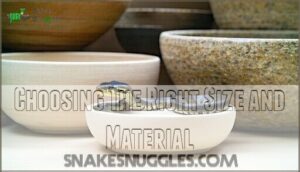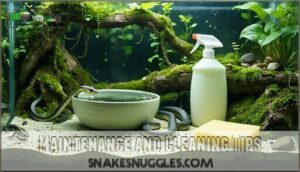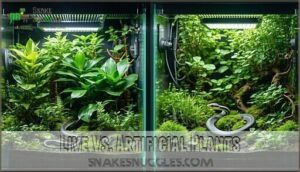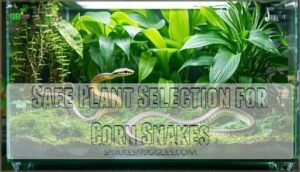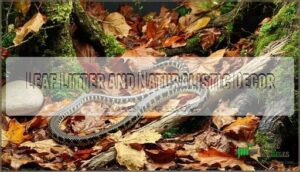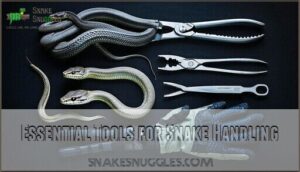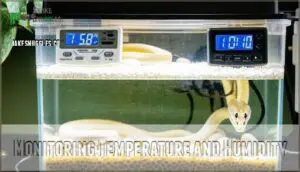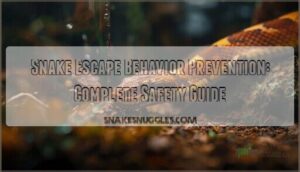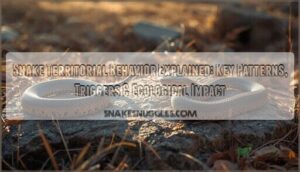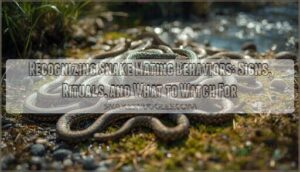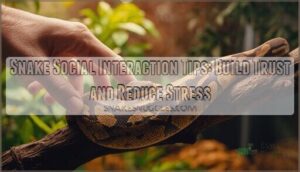This site is supported by our readers. We may earn a commission, at no cost to you, if you purchase through links.
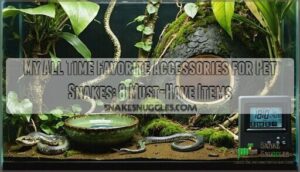
You absolutely need two hiding spots—one on the warm side, one on the cool side—because snakes genuinely stress out without places to retreat.
Branches for climbing are fantastic too, giving active species like ball pythons and corn snakes a chance to stretch and explore above ground level.
Digital thermometers and hygrometers beat analog versions hands down for accurate readings. Don’t forget snake-safe plants like pothos for visual appeal, though artificial options work if you’re not green-thumbed.
With the right accessories, you’ll turn a basic enclosure into something that actually feels like home for your snake.
Table Of Contents
- Key Takeaways
- Best Water Dishes for Pet Snakes
- Must-Have Hides for Snake Security
- Climbing Branches for Enrichment
- Using Plants in Snake Enclosures
- Hammocks and Lounging Accessories
- Leaf Litter and Naturalistic Decor
- Essential Tools for Snake Handling
- Monitoring Temperature and Humidity
- Frequently Asked Questions (FAQs)
- What are some benefits of using a water dish for pet snakes?
- How many hides are recommended for pet snakes and why?
- What are the advantages of using live plants in a snake’s enclosure?
- Why do corn snakes enjoy climbing branches?
- What substrate works best for corn snakes?
- How often should I replace terrarium lighting?
- Do snakes need UVB lighting supplementation?
- Whats the ideal enclosure size for adults?
- How do I prevent mites and parasites?
- Conclusion
Key Takeaways
- You’ll need at least two hides—one warm and one cool—plus heavy ceramic water dishes to create secure spaces where your snake can thermoregulate and feel safe. Digital thermometers and hygrometers beat analog versions for monitoring your snake’s environment, helping you catch dangerous temperature or humidity fluctuations before they become health problems. Climbing branches and vertical enrichment transform basic setups into engaging habitats that encourage natural behaviors and reduce stress, even for ground-dwelling species like corn snakes. * Snake-safe plants, proper handling tools like hooks and tongs, and naturalistic decor like leaf litter work together to create thriving ecosystems that promote your snake’s physical and mental wellbeing.
Best Water Dishes for Pet Snakes
You’ll want a heavy ceramic or stainless steel water dish that won’t tip when your snake decides to take an impromptu bath at 2 AM.
Choose one large enough for your snake to soak completely, because clean water isn’t just about hydration—it’s essential for proper shedding and overall health.
Importance of a Heavy Water Dish
Most snake owners learn the hard way that lightweight water dishes become scattered toys. Your snake needs a heavy water dish to prevent constant tipping during exploration and soaking sessions.
A sturdy dish ensures consistent water access for hydration and helps maintain proper humidity levels. Choose ceramic or thick plastic materials that won’t budge when your snake decides it’s bath time.
Choosing The Right Size and Material
You’ll want a water dish that matches your snake’s body diameter – think "cozy bathtub," not swimming pool. For adult ball pythons, aim for 16+ oz capacity bowls. Ceramic and food-safe materials beat plastic for reptile habitat safety and long-term durability. Heavy dishes won’t tip when your snake decides to redecorate.
Selecting the right bowl involves considering factors like material, size, and shape. Consider your enclosure size and terrarium design when selecting reptile supplies for snake habitat functionality.
Maintenance and Cleaning Tips
Regular cleaning keeps your snake habitat healthy and bacteria-free. Clean the water dish daily or every other day to prevent bacterial growth. Proper water quality and disinfecting decor prevent illness during shedding management periods. To maintain good hygiene, regular cleaning prevents bacterial growth and contamination.
- Use reptile-safe disinfectant, scrub thoroughly, then rinse multiple times before refilling
- Clean up any feces, urate, dirty substrate, water spills, or old skin daily
- Replace water completely rather than topping off to maintain good substrate sanitation
Must-Have Hides for Snake Security
You’ll need at least two hides in your snake’s enclosure—one on the warm side and one on the cool side—to help your pet feel secure and regulate stress levels effectively.
Think of hides as your snake’s personal retreat centers, where they can escape when feeling vulnerable, much like how you might need your own quiet space after a long day.
Warm and Cool Side Hide Placement
Every snake needs at least two hiding spots—think of it as giving them options.
Set up one hide on the warm side where your heating element keeps things around 85–88°F. Then place another hide on the cooler end, where temperatures stay between 75–78°F.
When your snake has choices between warm and cool spots, they can regulate their body temperature just like they would in the wild. Having multiple hideouts also means less stress and more natural behaviors.
Always use thermometers to verify your temperature control works correctly.
Material Options for Hides
When choosing hides, plastic trumps wood for cleaning ease and durability. Ceramic and resin options offer excellent alternatives to heavy rock materials. Avoid porous materials that harbor bacteria—smooth surfaces work best.
Simple plant pots flipped upside down make great budget hides. Just make sure you’re using non-toxic materials that won’t harm your reptile while giving them a nice place to retreat.
Exo Terra Reptile Cave Sizing Guide
Precision matters when cave size meets species-specific needs. You’ll want to measure your snake’s thickest point and choose hides allowing comfortable entry without excess space.
Small caves measure 4.75"L x 5.5"W x 3"H, while XX-Large reaches 13"L x 11"W x 5.45"H. Your snake’s burrowing behavior guides selection—tight-fitting hides reduce stress.
Cave material safety ensures reptile accessories last, making these terrarium decorations essential for reptile habitat design and enrichment activities.
Climbing Branches for Enrichment
You’ll transform your snake’s enclosure from a basic setup into an engaging habitat by adding climbing branches that encourage natural behaviors.
Research shows that snakes with vertical enrichment are 24% more active than those in barren tanks, and honestly, watching your snake explore these branches never gets old.
Benefits of Vertical Space for Snakes
Most people assume snakes just need floor space, but that’s missing a big piece of the puzzle. Vertical climbing branches actually give your snake fantastic exercise that matches what arboreal species do in the wild.
When they can stretch up and work through different levels, their muscle tone gets noticeably better.
Adding climbing branches and elevated spaces cuts down on stress and keeps your snake more active. Even corn snakes that naturally stick to the ground enjoy exploring upward sometimes, so don’t skip the hammocks and raised hideouts when setting up their home.
Types of Climbing Branches
Your snake’s climbing paradise starts with choosing the right branches. Natural hardwood branches like manzanita or driftwood offer excellent Branch Material Safety and durability. Cork bark provides lightweight, textural variety that’s easy to clean. Artificial branches work well too, especially resin or plastic options designed for reptiles.
Branch Size Matters—pick diameters ranging from pencil-thin to your snake’s body width for the best grip. Consider Branch Sourcing Options from reptile stores, online suppliers, or properly sanitized wild finds.
This environmental enrichment transforms any snake aquarium into an engaging climbing wonderland.
Safe Installation Tips
Once you’ve selected your branches, installing them properly protects your snake and creates a stress-free environment.
Snake-proof your enclosure with sturdy fixtures that can handle even the most ambitious climbing sessions without giving way.
- Check weight capacity – Secure fixtures to terrarium walls using proper mounting hardware
- Plan cord management – Route heating cables away from climbing areas to prevent burns
- Avoid toxic materials – Skip treated wood or painted branches that could harm your pet
- Create escape-proof setup – Make certain branches don’t create ladder routes to loose latch points
Smart reptile enclosure design prevents accidents while maximizing enrichment opportunities.
Using Plants in Snake Enclosures
You’ll transform your snake’s enclosure from basic to breathtaking when you add plants that create natural hiding spots and visual interest.
Both live and artificial plants work well, but you’ll need to choose snake-safe species and maintain proper placement to prevent your pet from getting tangled or stressed.
Live Vs. Artificial Plants
When choosing between live and artificial plants for your terrarium, think about how much time you want to spend on upkeep and how important snake safety is to you.
Real plants look great and create a more natural environment, but they need regular watering, trimming, and you’ll have to watch out for toxic varieties that could harm your snake.
Fake plants skip all that hassle while still making your enclosure look good and giving your snake something interesting to explore. They’re perfect if you’re busy but still want a nice-looking setup.
Safe Plant Selection for Corn Snakes
Now that you’ve decided on live plants, selecting safe species becomes your top priority for corn snake care. Toxic plant identification prevents serious health risks, while edible plant options like pothos and snake plants offer peace of mind.
Here are five proven safe choices:
- Pothos – Nearly indestructible and endures snake traffic
- Snake Plant – Ironically perfect for reptile habitat design
- Boston Fern – Thick leaves resist climbing damage
- Spider Plant – Safe if nibbled, easy maintenance
- Chinese Evergreen – Tolerates enclosure conditions well
These species thrive in typical corn snake environments while avoiding toxic compounds.
Plant Placement and Maintenance
Your terrarium’s success starts with smart Reptile Habitat Design that recreates nature. Keep plants well away from heat sources—they’ll wilt fast if placed too close.
Live plants need proper Lighting Needs and regular watering—check Soil Choice weekly. Keep substrate moist around live plants but avoid waterlogging. Remove dead leaves promptly to prevent bacterial growth.
Artificial plants require minimal care but occasional cleaning.
Hammocks and Lounging Accessories
You’ll find that hammocks aren’t just for humans—your snake will appreciate having an elevated spot to rest and observe their territory.
These accessories provide mental stimulation while giving your pet a cozy place to lounge, much like how you might enjoy a good book in your favorite chair.
Why Snakes Enjoy Hammocks
Comfort becomes a priority when you’re creating the perfect snake habitat. Your snake will appreciate hammocks because they provide elevated resting spots that mimic natural tree branches.
This positioning offers Climbing Benefits and improves Snake Posture while reducing stress on joints. The Enrichment Value is significant – hammocks encourage natural behaviors and increase activity levels.
Studies indicate that these elevated platforms lead to better muscle development and increased mental engagement, supporting your snake’s overall health through improved care routines.
Hammock Materials and Mounting Ideas
Now that you know your snake loves hammocks, let’s talk about the practical stuff. Material durability matters most for hammock safety – cotton and canvas hold up better than mesh. For mounting techniques, suction cups work great on glass walls, while clips attach to screen tops.
Here are key considerations:
- Choose washable fabrics for easy cleaning hammocks and reptile care maintenance
- Test weight limits before installation – safety first with your pet care setup
- Position hammocks away from heat sources to prevent material breakdown
- Consider DIY hammocks using reptile-safe materials for budget-friendly reptile supplies
Quality mounting prevents accidents, and regular cleaning keeps your snake healthy. Most commercial options include mounting hardware, but double-check weight ratings for your snake’s size.
Leaf Litter and Naturalistic Decor
You’ll transform your snake’s terrarium into a miniature forest floor when you add leaf litter and naturalistic decorations to create a biologically appropriate habitat.
Research shows that snakes in enriched environments with natural substrates display more natural behaviors and reduced stress levels, plus your guests will think you’ve got a slice of the Amazon right in your living room.
Research shows that snakes in enriched environments display more natural behaviors and reduced stress levels, creating what looks like a slice of the Amazon in your living room
Benefits of Leaf Litter for Snakes
Three key benefits make leaf litter a major plus for your snake’s wellbeing. This naturalistic substrate promotes natural foraging behavior, letting your snake explore like they would in the wild.
Leaf litter also provides excellent humidity regulation, creating microclimates that foster beneficial microfauna.
These enrichment benefits reduce stress while fostering overall reptile health and wellness through improved snake care routines.
Creating a Natural Habitat Look
Building your terrarium’s natural aesthetic starts with thoughtful background design that mimics wild habitats. Layer naturalistic substrate like cypress mulch beneath artificial plants and scattered leaves for depth.
Position rock features strategically around branch placement to create visual interest. Your reptile supplies should include varied textures and heights.
Proper lighting effects highlight these elements beautifully, transforming basic substrate into a convincing woodland scene.
Safe Decor Materials
When selecting decorations, prioritize reptile-safe materials that won’t harm your snake. Many common household items contain toxins that can seriously injure reptiles.
- Safe wood types include oak, maple, and birch branches
- Non-toxic plastics marked with recycling codes 1, 2, or 5
- Avoid painted or treated materials that release chemicals
- Natural alternatives like cork bark provide excellent texture
- Establish cleaning protocols using reptile-safe disinfectants regularly
Research resin safety before adding decorative pieces.
Essential Tools for Snake Handling
You’ll need proper tools to handle your snake safely, especially during cage cleaning or veterinary visits. Snake hooks and quality gloves protect both you and your pet from stress-induced bites.
Tongs help you move food or clean without getting too close to the business end of a hungry snake.
Snake Hooks and Tongs
Moving from natural decor to handling tools, you’ll need proper snake hooks and tongs for safe handling. These tools keep distance between you and your snake during cage cleaning or health checks. Quality hooks reduce stress for both reptile owner and pet while preventing injury.
| Tool Type | Length Options | Best Hook Material |
|---|---|---|
| Snake Hook | 24"-60" | Stainless Steel |
| Feeding Tongs | 10"-18" | Coated Metal |
| Multi-Hook | 30"-48" | Aluminum Alloy |
| Tube Restraint | 6"-12" | Clear Acrylic |
Match your tong length to your snake’s size – longer snakes need longer tools. Start handling sessions short and build up gradually. Don’t grab your snake with bare hands.
Hooks spread their weight naturally across the body instead of creating pressure points. This gentler approach keeps stress low during routine care like cleaning and health checks.
Gloves for Safe Handling
Quality gloves protect you from defensive bites while reducing stress for your snake. Nitrile or leather glove materials offer excellent bite protection during handling frequency increases.
Fresh gloves keep things hygienic and stop bacteria from spreading between you and your snake.
As a reptile owner focused on animal health and wellness, gloves promote responsible pet ownership and reptile handling and safety practices for effective snake care and maintenance.
Zilla Terrarium Screen Clips Usage
Beyond protective gloves, you’ll need reliable screen security for your terrarium. Zilla Terrarium Screen Clips prevent escapes by securing mesh tops that might otherwise pop loose. Here’s how to use them effectively:
- Clip Size: Match clip dimensions to your terrarium’s screen thickness for best latch function
- Clip Placement: Position clips at opposite corners first, then add intermediate clips for larger enclosures
- Clip Maintenance: Check weekly for wear or loosening that could compromise screen security
Every reptile owner needs these simple yet key reptile supplies for reptile handling and safety.
Monitoring Temperature and Humidity
You can’t maintain a healthy snake without accurate temperature and humidity readings, which is why quality thermometers and hygrometers aren’t optional accessories—they’re lifesavers.
Think of these instruments as your snake’s personal weather station, helping you catch potentially dangerous fluctuations before they turn into expensive vet visits or worse.
Thermometers and Hygrometers
Your snake’s health depends on getting the temperature and humidity exactly right.
Digital thermometers and hygrometers take the guesswork out of terrarium monitoring, giving you precise readings when it matters most.
Herpetology experts recommend digital models for reliable heat gradient monitoring. Most reptile supplies now include combo units measuring both temperature and humidity simultaneously.
Maintaining a Proper Temperature Gradient
Your terrarium needs a proper heat gradient, like creating zones in your house. Place your heating element on one side to create a basking spot design that reaches species-specific needs. Use thermostat calibration to prevent overheating. Allow nighttime temperature drop naturally.
This heating element safety approach ensures your reptile can thermoregulate properly, keeping any reptile owner happy with their herpetology setup.
Tips for Humidity Control
Temperature’s easy to track, but humidity? That’s trickier. Your terrarium needs the right substrate moisture and regular misting to keep 50-70% humidity.
- Monitor humidity using digital hygrometers placed at different terrarium levels
- Adjust enclosure ventilation by partially covering screen tops during dry seasons
- Install a humid hide filled with damp moss on the warm side
- Maintain water supply through larger water dishes that increase evaporation
- Control substrate moisture by misting substrate corners, not the snake directly
Every reptile owner discovers that humidity monitoring becomes second nature with quality reptile supplies and consistent routines.
Frequently Asked Questions (FAQs)
What are some benefits of using a water dish for pet snakes?
Water dishes provide essential hydration, allow soaking during shedding, help maintain proper humidity levels, and offer thermoregulation opportunities. You’ll want a heavy dish that won’t tip over easily.
How many hides are recommended for pet snakes and why?
You’ll need at least two hides for your pet snake – one on the warm side and one on the cool side of the enclosure.
This setup lets your snake thermoregulate while staying secure and stress-free.
What are the advantages of using live plants in a snake’s enclosure?
Live plants offer natural air purification, helping maintain healthy humidity levels while creating a more authentic environment.
They’re safer than artificial alternatives since there’s no risk of ingestion causing blockages or toxicity issues.
Why do corn snakes enjoy climbing branches?
Corn snakes naturally climb trees in the wild, so branches satisfy their instinct to explore vertically.
Climbing provides exercise, mental stimulation, and helps them regulate body temperature by moving closer to or away from heat sources.
What substrate works best for corn snakes?
Absolutely nothing beats aspen bedding—it’s absorbent, allows for natural burrowing, and maintains the ideal 40-50% humidity levels your snake needs.
You’ll love how easy it makes spot cleaning while supporting their instinctive digging behavior perfectly.
How often should I replace terrarium lighting?
You’ll replace terrarium lighting bulbs every six to twelve months. UVB bulbs lose effectiveness over time , even when they still produce visible light, so mark replacement dates for your snake’s health.
Do snakes need UVB lighting supplementation?
Yes, corn snakes benefit from UVB lighting for calcium metabolism and bone health. While they’re nocturnal, research shows UVB helps prevent metabolic bone disease and improves overall well-being.
Whats the ideal enclosure size for adults?
Adult corn snakes need a 40-gallon long tank minimum, though bigger is better. You’ll want 75+ gallons for greatest comfort and enrichment opportunities.
How do I prevent mites and parasites?
Keep your snake quarantined before introducing it to your collection.
Wash your hands before and after handling, as well as disinfecting any supplies you buy secondhand with bleach.
Regular enclosure cleaning prevents mite infestations.
Conclusion
Surprisingly, you’ll find that my all-time favorite accessories for pet snakes work together like pieces of a puzzle—each one enhancing your snake’s quality of life in unexpected ways.
These eight essentials create environments where snakes display natural behaviors, reducing stress and promoting longevity. You’ve got the tools to transform any basic setup into a thriving ecosystem.
Your snake will thank you with confident movement, regular feeding, and those peaceful coiled rests that signal contentment.
- https://pmc.ncbi.nlm.nih.gov/articles/PMC11926773/
- https://www.wiseguyreports.com/reports/pet-snakes-market
- https://www.kwikpets.com/blogs/reptiles/7-bedding-options-for-your-pet-snake
- https://www.zenhabitats.com/collections/enclosures-accessories
- https://reptifiles.com/boa-constrictor-care/boa-constrictor-humidity/


